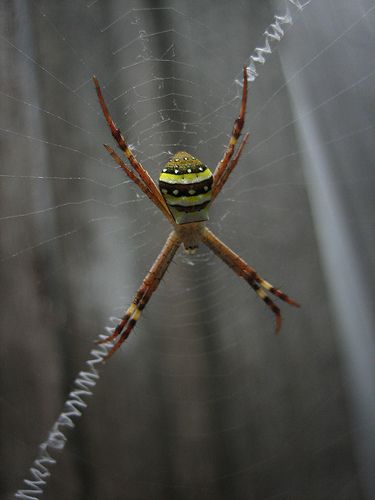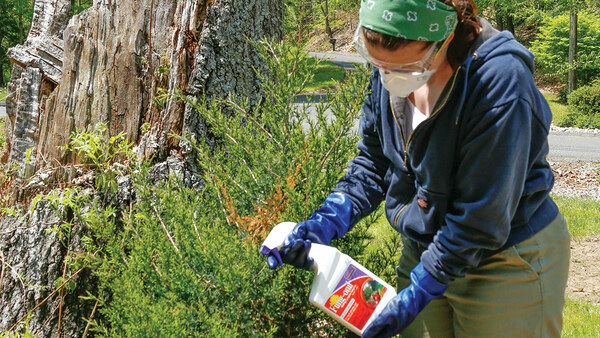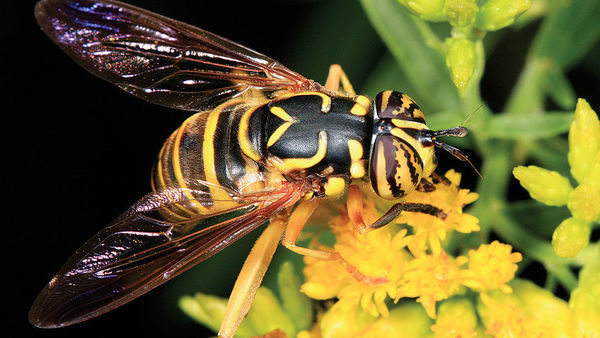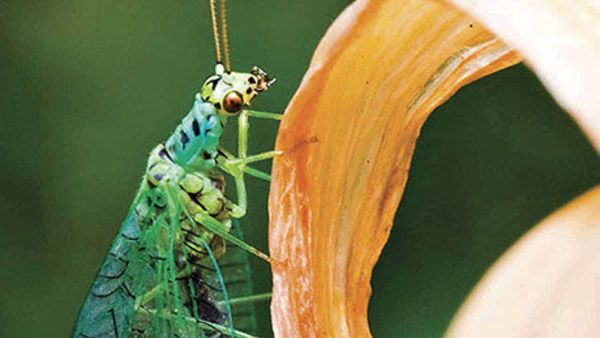
Here it is in suburban farmer speak: “Don’t use a bulldozer when a hand trowel will do.”
The idea here is starting with the least toxic remedy to a potentially bad situation and move up the ladder. It’s one technique used in sustainable gardening practices. Before I actually used IPM, I listened in on a talk with a heavy sigh in my chest. On one hand, I’d be looking at a bug card, making sure to keep an intensely studious look on my face. On the other hand I’d be metaphorically unscrewing the cap of an Ortho product. The speaker held up a picture and I recognized the evil bug. It turns out it was a soldier beetle; slayer of all aphids. I think it was then that I decided to screw the cap back on.
For the most part IPM relies on the farmer monitoring and gathering information. Don’t panic, not at Stanford University level; just on your own little plants in your own backyard. Here’s how the Integrated Pest Management system is practiced in a nutshell.
1. Name That Bug – The first thing we modern farmers have to realize is that the mere presence of an insect does not a problem make. In other words, what kind of bug is it? How do you know it’s eating your plants? In the soldier beetle’s case, he’s the cavalry. He’s there to rid your produce of aphids. Are you going to thank him by dousing his scrawny bug butt in poison? I thought not.
Learn your creatures, dudes. Nothing book-worthy – just the locals. If you really have no idea what the heck you little insect is, catch it in a jar. Bring it on down to your local nursery for proper identification. You were probably going down there anyway to grab some of those heirloom tomato plants.
2. Assess The Damage – Has all your baby spinach become a snail family’s dinner? Or are there a couple of cosmetic blemishes on a few pieces of fruit? Has this pest move all of his family and friends into your place? Or is it just the two of them on a day trip? Think about it; there’s a broad difference. Sometimes, you really don’t need to do anything. In the case of slightly blemished fruit, you have to admit the natural balance of things is pretty stable. If those are all the worries you have, then that critter’s natural enemies must be plentiful in your garden. In fact, if that is all the worries you have, this is what we call successful gardening.
3. Look For The Cavalry – Where there are bad guys, there are bound to be good guys otherwise known as beneficial insects. See if you can spot them. Remember, pesticides are the biggest non-discriminators in the world. They’ll kill ‘em all and let God sort ‘em out. A great bug identifier to have hanging around your backyard farm is Mac’s Field Guide. It’s available through Amazon.com and is laminated, so you can throw it just about anywhere. On one side you’ll find the good garden bugs and on the flip side the bad ones. It tells you where you’ll find both types of bugs as well as which plant whets their appetite.
4. How Many Pests Can You Tolerate? – Something else to think about is that everyone has their personal tolerance levels. One person may figure that the damage isn’t a big deal; plus insects provide food for wildlife, as well. Another person may feel that the particular plant isn’t worth the hassle. They may choose to rip out that one and replace it with a more pest-resistant species altogether.
IPM Control Methods
- Physical Controls – Copper strips, diatomaceous earth and hand picking/tossing work well for snail control. Sticky traps can be put out in a place where an undesirable amount of pests are setting up camp. These are good examples of getting physical.
- Horticultural Controls – This includes choosing plant varieties that are labeled as disease or pest-resistant. Also, keep your plants healthy; healthy plants are the least susceptible to the bad dudes. Part of keeping plants healthy is to remove any foliage that could be diseased and discard it permanently in the garbage. Any plant remains that are suspect of disease shouldn’t be tossed into your compost pile either. Another horticultural control is a technique called companion planting to either mask the scent of a desirable crop or to distract or confuse the bad guys.
- Biological Controls – Invite (or go out and purchase) other living creatures that eat insects and their larva. For the most part, if you don’t use a lot of pesticides in your garden you’ll have a healthy supply of beneficial insects in your garden by default.
- Least-toxic Chemical Controls – You are going to have times where you need to use chemical controls, but this is the last resort in the IPM lineup. That said, ya gotta do what ya gotta do. Make sure you read the labels and follow the instructions. There are products that are the least disruptive to the neighbors of the offending party and our waterways; buy those. These include insecticidal soaps, oils, other oils derived from plants (neem tree and mint), boric acid, borax, and borates.
IPM Doesn’t Prohibit Pesticides
On occasion, bigger is better and a larger gun is necessary. If you decide you do have a major pest problem and you’d like them to just get the hell out of Dodge, pesticides are a valuable tool. But they should be chosen and applied carefully so they can be the least hazardous to people, pets, and the environment. “Spot treating” is really the way to go when it comes to pesticides in the farm or garden.
Use pesticides exactly where they work best and when they are needed although this may have to be done a couple of times to be perfectly effective. In this way, you are using a hoe (albeit a slightly larger hoe) in place of a bulldozer. Here are some things to think about before spraying pesticides:
- Some insects are affected by treatments only during certain stages of their lifecycle.
- Indiscriminately spraying pesticides can kill natural enemies which are often more vulnerable to the pesticides than the pest.
- Spraying you farm or garden monthly unnecessarily exposes humans, pets and the environment to toxic chemicals. Here’s the rub: the pests may not be around in great enough numbers to even worry about or may not even be around at all. Assess the situation first.
Utilizing the method of Integrated Pest Management how I garden – period. I’m probably going to get strung up by the organic gardening police for that admission; but before you set the torch afire let me say this. I can’t think of the last time I’ve resorted to any chemicals at all except for Sluggo (and iron phosphate is an organic control so even that doesn’t count). Consider me a living testament to organic gardening because the organic methods work so well that I never get close to the level of even low-toxic chemicals. Which makes me an organic gardener by default. Now, put down the rope and consider me the perfect litmus test.



















Comments
A pest in one area may not be considered a pest elsewhere. Often organisms rise to pest status because they escape normal control by natural regulating agents. This is achieved through direct or indirect importation to a new region or by human activities which reduce or eliminate the efficiency of their natural enemies. Without controls on population growth, organisms can rapidly achieve levels at which damage is caused thus becoming pests (e.g., locust swarms stripping landscapes bare). However, organisms do not need to exist in large numbers to be a pest. https://www.jopestkil.com/
Integrated Pest Management (IPM) is an increasingly popular process for controlling pests. IPM considers the ecosystem as a whole and takes into consideration a balanced mix of the aforementioned control methods to produce the most effective and least damaging plan. All the methods are mutually augmentative with chemical control means as the last resort in the plan. Ideally, an IPM plan would result in a sustainable system without need for much costly follow-up maintenance.
A number of insects and pathogens have been identified as pests particularly for their impacts to vineyards, orchards, and other agricultural industries important to our economy. Many pest species in the world have so much deleterious effects. https://www.fumigationpestcontrolservices.co.ke/
Log in or create an account to post a comment.
Sign up Log in